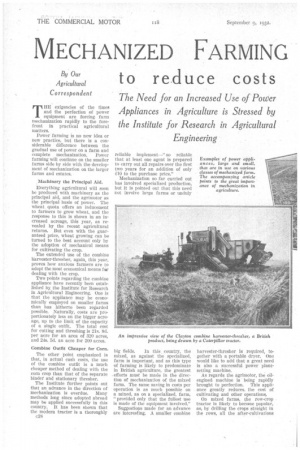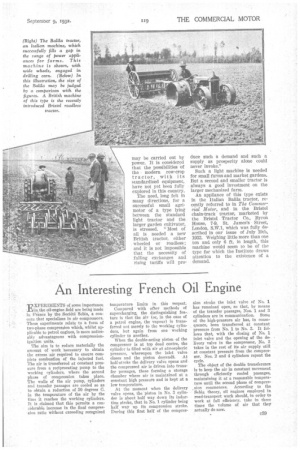MECHANIZED FARMING
Page 60

Page 61

If you've noticed an error in this article please click here to report it so we can fix it.
to reduce costs
The Need for an Increased Use of Power Appliances in Agriculture is Stressed by the Institute for Research in Agricultural Engineering
By Our Agricultural Correspondent
THE exigencies of the times and the perfection of power equipment are forcing, farm mechanization rapidly to the forefront in practical agricultural matters.
Power farming is no new idea or new practice, but there is a considerable difference between the gradual use of power on a farm and complete mechanization. Power farming will continue on the smaller farms side by side with the development of mechanization on the larger farms and estates.
Machinery the Principal Aid.
Everything agricultural will soon be produced with machinery as the Principal aid, and the agrimotor as the principal basis of power. The wheat quota offers an inducement to farmers to grow wheat, and the response to this is shown in an increased acreage, this year, as revealed by the recent agricultural returns. But even with the guaranteed price, wheat growing can be turned to the best account only by the adoption of mechanical means for cultivating the crop.
The extended use of the combine harvester-thresher, again, this year, proves how anxious farmers are to adopt the most economical means fair dealing with the crop.
Two points regarding the combine appliance have recently been established by the Institute for Research in Agricultural Engineering. One is that the appliance may be economically employed on smaller farms than has hitherto been regarded possible. Naturally, costs are proportionately less on the bigger acreage, up to the limit of the capacity of a single outfit. The total cost for cutting and threshing is 21s. 8d. per acre for an area of 320 acres, and 24s. 5d. an acre for 200 acres.
Combine Outfit Cheaper for Corn.
The other point emphasized is that, in actual cash costs, the use of the combine outfit is a much cheaper method of dealing with the corn crop than that of the separate binder and stationary thresher.
The Institute further points out that an advance in the direction of mechanization is overdue. Many methods long since adopted abroad may be applied successfully in this country. It has been shown that the modern tractor is a thoroughly e38 reliable implement—" so reliable that at least one agent is prepared to carry out all repairs over the first two years for an addition of only i10 to the purchase price."
Mechanization so far carried out has involved specialized production, but it is pointed out that this need not involve large farms or unduly big fields. In this country, the mixed, as against the specialized, farm is important, and as this type of farming is likely to predominate in British agriculture, the greatest .efforts must be made in the direction of mechanization of the mixed farm. The same saving in costs per operation is as much possible on a mixed, as on a specialized, farm, "provided only that the fullest use is made of the equipment involved."
Suggestions made for an advance are interesting. A smaller combine harvester-thresher is required, together with a portable dryer. One would like to add that a great need is also a successful power plantsetting machine.
As regards the agrimotor, the oilenginecl machine is being rapidly brought to perfection. This appliance greatly reduces the cost of cultivating and other operations, On mixed farms, the row-crop tractor is likely to become popular, as, by drilling the crops straight in the rows, all the after-cultivations
may be carried out by power. It is considered that the possibilities of the modern row-crop tractor, with its standardized equipment, have not yet been fully explored in this country.
The need, long felt in many directions, for a successful small agrimotor of a type lying between the standard light tractor and the larger garden cultivator, is stressed. "Most of all is needed a new British tractor, either wheeled or roadless; and it is not impossible that the necessity of falling exchanges and rising tariffs will pro duce such a demand and such a supply as prosperity alone could never invoke."
Such a light machine is needed for small farms and market gardens. But a second and smaller tractor is always a good investment on the larger mechanized farm.
An appliance of this type exists in the Italian Balila tractor, recently referred to in The Commercial Motor, and in the Bristol chain-track tractor, marketed by the Bristol Tractor Co., Byron House, 7-9, St. James's Street, London, S.W.1, which was fully described in our issue of Suly 19th, 1932. Weighing little more than one ton and only 6 ft. in length, this machine would seem to be of the type for which the Institute draws attention to the existence of a demand.












































































































